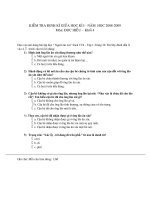Minerals identification 4 1
Bạn đang xem bản rút gọn của tài liệu. Xem và tải ngay bản đầy đủ của tài liệu tại đây (2.98 MB, 51 trang )
Section 1: Properties of
Minerals
What is a mineral?
How are minerals identified?
mineral – A naturally occurring, inorganic solid that has a crystal
structure and a definite chemical composition.
A substance must have all 5 characteristics to be classified as a
mineral.
A mineral must be/have:
Naturally Occurring
Inorganic
Solid
Crystal Structure
Definite Chemical Composition
The substance must be formed
by processes that occur naturally
in the world
Example: quartz
Forms naturally when magma
cools and hardens deep beneath
the Earth’s surface.
Materials such as cement, plastic, brick, steel, and
glass all come from substances found in Earth’s
crust but they are manufactured by people.
Inorganic – the mineral cannot arise from materials
that were once part of a living thing
Ex. Coal is NOT a mineral because it is made up the
remains of plants and animals
A mineral is always solid
Has a definite volume and shape.
Particles that make up a solid are tightly packed together, therefore they move very little
(compared to the particles of a liquid)
Particles of the mineral line up in a pattern that repeats.
The repeating pattern of the minerals particles forms a solid
called a crystal
Faces – are flats sides of the crystal
that meet at sharp edges and
corners
Element – a substance composed of a single kind of atom.
Ex. Hydrogen
Compound – Two or more elements combined so that the
elements no longer have distinct properties
Ex. Water H20
Minerals always contain certain elements in definite proportions; most
minerals are compounds
example: Quartz
SiO
2
One element of silicon, 2 elements of oxygen
Compounds have their own unique properties that differ from the
properties of the elements that form it.
Some elements that occur in nature, in pure form, that are
minerals include:
Gold (Au), Silver (Ag), Copper
(Cu)
Listed on the periodic table
Geologists have identified about 3,800 minerals
Each mineral has characteristic properties that can be used to
identify it.
Some properties can be determined by looking at it, some
properties require testing.
Color
Streak
Luster
Density
Hardness
Crystal Systems
Cleavage and fracture
Special Properties
An easily observed physical property.
Color alone is not enough to make an identification.
Ex. Gold, pyrite and chalcopyrite = gold
color
Only a few minerals can be identified using color only.
Ex. Malachite- always green, azurite –
always blue.
The streak of a mineral is the color of its powder
The streak color and the mineral color are often different
To test: rub a mineral against an unglazed tile (streak plate)
Luster – used to describe how a mineral reflects light from
its surface.
Minerals containing metals are often shiny.
Other terms to describe luster - Earthy, waxy, and pearly.
Each mineral has a characteristic Density.
Density – the mass in a given space or mass per unit volume.
Density = mass (g)
volume (cm3)
Displacement – the volume of the displaced water equals the
volume of the sample
- Properties of Minerals
To calculate the density of a mineral, divide the mass of the mineral
sample by its volume.
Density = Mass/Volume
For example, if a sample of olivine has a mass of 237 g and a volume
of 72 cm3, then the density is
237 g/72 cm3 = 3.3 g/cm3
Take a few minutes to work through the following problem with a partner.
A sample of calcite has a mass of 324 g and a volume of 120 cm3. What is its density?
324 g ÷ 120 cm3 = 2.7 g/cm3
Take a few minutes to work through the following problem with a partner.
- Properties of Minerals
Predicting:
A piece of pyrite has a
volume of 40 cm3. What is
its mass?









